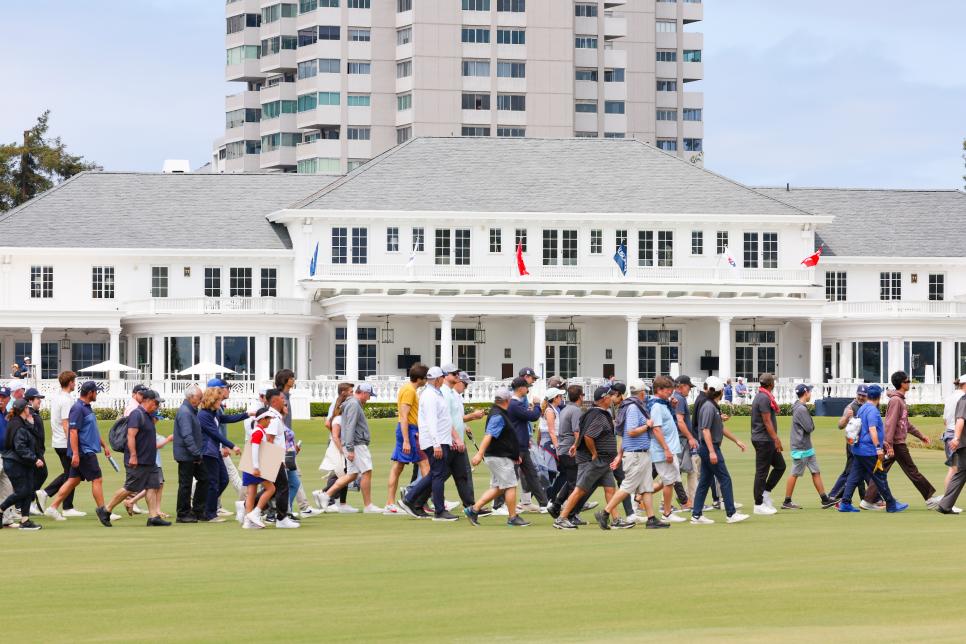One of modern professional golf’s biggest obstacles is that great courses and great tournament venues aren’t always the same thing. Look no further than Los Angeles Country Club, host of the 123rd US Open, where this week the pros have been teeing off the first hole on what is usually half the practice putting green.
At LACC this week, views are best from the 19th hole. Members in the clubhouse and guests in the corporate suites of Bank of America, Chase, JP Morgan and Cisco have an unobstructed view of the 18th green, but from a considerable distance back. They are, however, able to watch the pros tee off on No.1 from only a few feet away.
Architecturally, LACC has it all. It’s got a 300-yard par 3 and an 80-yard par 3. It’s got thoughtful par 5s like No.14, with the former Playboy Mansion located behind a hedge off the tee box, and drivable par 4s like No.6.
But balancing the needs of corporate infrastructure with those of fee-paying fans on a golf course designed in the Golden Age of the 1920s is no easy task. It’s one of the reasons the USGA capped tickets at 22,000 a day, of which the majority are corporate-skybox buyers and LACC members. Public sales were limited to about 9,000, according to the USGA.
The 18th hole is the perfect example of those restrictions.
Crowning the winner Sunday is at risk of lacking the roars that golf’s second-oldest championship deserves. The area around the 18th at LACC is like most properties in LA’s real estate market—there’s not a lot of room.
“It’s is a great hole, but not for spectators,” Cameron Smith, the reigning Open champion, said.
There is a grandstand short and left of the 18th green that seats almost 1,000. But they couldn’t let any fans beyond that because the ninth green and 10th tee are right there, too. Behind the 18th green is a small grandstand with limited seats open to the public. On top of it is a deck for ticketed guests of the “Clubhouse Lawn Skybox”.
Fans can’t walk down the right side of the 18th, which is where most pros aim their drives. Instead, there’s a roped off area between Nos. 1 and 18 but it ends at least 100 yards out from the green, and the greenside bunkers hide the pros while they’re putting.
Putting a massive grandstand behind the green was troublesome.

Fans cross the 18th fairway during a practice round, but don’t have close-up access to watch the the green. Jeff Haynes
“Given that 1, 9 and 18 all come together in front of the clubhouse with little space between the holes, combined with the slope and barranca, it was very difficult to accommodate a large grandstand,” a statement from the USGA read. It’s not unusual, either. At The Country Club at Brookline last year and Pinehurst No. 2 for several Opens, the clubhouses aren’t obscured, but there are far bigger grandstands for the public than at LACC.
There also is another good reason for no stands in front of the LACC clubhouse. Members paid a sizable premium for their patio views.
The USGA confirmed for Golf Digest it is considering allowing fans—secured by ropes, of course, to walk down the fairway behind the final group on Sunday—but only if there is no chance for a playoff.
The 18th is not the only hole at LACC where fans struggle to see certain shots. Several holes on the front nine restrict fans, while the brilliant, short par-4 12th ropes off the gallery on the right-hand side at about 70 yards short of the green. A lot of this is caused by the barranca running through LACC, which has several bridges over it.
Players are cognizant the golf course has limited what the USGA can do. It’s just had an effect on volume of the fans. Fitzpatrick made an ace Friday at the short par-3 15th. The cheers were loud, but not as robust as they should be for the defending champion making an ace. “I wish it would have been louder,” Fitzpatrick said. “I wish it was a few more people.”
“They limited the amount of people out here this week and you can tell,” Patrick Cantlay, a Southern California native, said. Added Smith: “There are a couple holes out there like that where it kind of feels like it in the middle of nowhere, and at a major it usually feels like everyone’s on top of you.”
It’s all a cost of taking the US Open to a course ranked in the country’s top 20 by Golf Digest, and for peeling back the curtain one of its most exclusive clubs. It will not go down as a traditional US Open, but when has L.A. ever been traditional?



